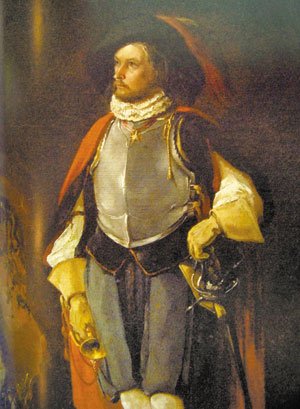Museum detective stories
How an unknown Italian painter’s canvas turned into a self-portrait of a famous Russian artist
A Portrait of a Military Man painted by an unknown Italian artist of the 19th century and self-portrait of the Russian artist Nikolay Lomtev in Hoftrompeter’s (court bugler) costume. Can you see the difference? Meanwhile, it is the same work, before and after attribution. Attribution is a laborious, frequently thankless task, which also reminds of detective stories with an artistic flavor.
The National Bohdan and Varvara Khanenko Museum of Arts has the so-called ZhB Fund. It preserves the paintings which have “no museum value.” The fund was especially replenished in the afterwar time, when damaged paintings were a regular thing. Until recently The Portrait of a Military Man by an unknown Italian painter has been preserved in this fund. But experienced art experts had doubts about the painting.
First, the features of the man depicted on the canvas are classical Slavic rather than Italian. Second, there is a strange inscription, “XXX OLIMPIA” and monogram NL. Third, the face expression of the hero, his pose, a wide-brimmed hat, and a bugle in his right hand raised doubts over the authenticity of the title “A Portrait of a Military Man. Painting by an unknown Ita-lian artist, 19th century.”
The research, which lasted for over six months, proved that the painting was in fact created in the mid-19th century (which is indicated by the inscription “ROMA 1845”). The age of the painting was defined with the help of infrared spectroscopy. The rest of assumptions turned out to be false. The monogram NL appeared to be the signature of the artist Nikolay Lomtev. Analogical signatures on his other paintings are proof of this.
When the canvas was created, Nikolay Lomtev (1816-59), a Russian artist, whose paintings were adored in particular by Pavel Tretyakov (in his time he even ordered four canvases from Lomtev) was studying in Rome. There is a photo featuring Lomtev with members of the Russian Artistic Union approximately at the same period of time. In this photo Lomtev is wearing a wide-brimmed hat, greatly resembling the one depicted on A Portrait of a Military Man. It was then that the art experts for the first time came up with an opinion that this might be a self-portrait. Further analysis, specifically comparison with other portraits of the artist and iconographic alanysis, proved this surmise after all. Lomtev depicted himself in a costume of a bugler at the feast of the 30th “Olympiad” (hence “XXX OLIMPIA”), the May holidays the artists arranged in the end of annual Rome carnivals. While celebrating “Olympiads” they disguised themselves in the costumes of various characters, frequently heroes. Therefore Lomtev put on the costume of a court bugler (Hoftrompeter).
The whole story could have remained a secret and Lomtev would have been considered an Italian colonel, be it not for Olena Zhyvkova, head of the department of West-European art at the Khanenkos Museum, who took interest in the portrait by an uknown artist. It was her who disentangled this detective story and, speaking professional language, made the attribution of the painting. She also told The Day about the joys and sorrows of the profession, which is rare in our time.
So, attribution answers three main questions: What? (Who?) Where? When? According to Zhyvkova, it is important to search the truth rather than fame, which is much more complicated. Though the 21st century is a time of high technologies, they are unable to substitute an expert and professional in making attribution. The state does not fund the research work (to which attribution belongs). It only covers the expenditures for heating, electricity, guard, and wages for the employees, but no money is alotted for the exhibition and scholarly-museum work. However the art experts who deal with attribution earn big money for the state, because the painting of an unknown Italian artist of the 19th century and a self-portrait of a famous Russian artist have totally different price ranges in the art market.
But Zhyvkova is even more upset with the problem of the state’s indifference to the best and most talented people, which has become commonplace in our country, and with the fact that schoolchildren, who come to the museum every day, are mostly interested in the cost of the item. Frequently it is hard to explain to them that some things cannot be measured by money.
Lomtev’s portrait has been restored, but it has not been included in the regular exposition. You would not believe: there was no decent frame.
Newspaper output №:
№62, (2011)Section
Time Out





